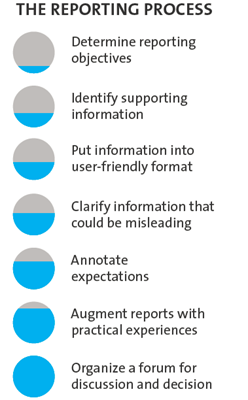By
Brad Cleveland
|
Date Published: December 16, 2013 - Last Updated August 22, 2018
|
Comments
Effective contact center reporting requires an ongoing communication process
Reporting contact center activity to senior level management and others in the organization can seem a daunting task. The wide variety of activities in a typical center, the reality of senior management not having the time to pour over detailed reports, and the fact that summary reports often gloss over important information, all contribute to the challenge. Consequently, many diligently prepared reports either go unread or, worse, are misunderstood.
Clearly, good communication doesn’t happen just because detailed information is available. Any manager buried in system reports yet struggling to convey basic realities can testify to that fact. As with budgets, the process you establish to communicate ongoing contact center activity is as important as the information itself. The following steps can help you identify and prepare meaningful reports and ensure that they are understood.

1. DETERMINE YOUR OBJECTIVES
What are the objectives for the reports? In other words, what should other managers know about the contact center or the information it has acquired, and why? To find the answers, assemble a team for a working discussion. A cross-section of managers from across the organization, contact center managers, supervisors and agents should be involved. General areas of concern usually include:
- Customer satisfaction and sentiment analysis
- Quality measurements
- Contributions to other business units
- Access alternatives and workload trends
- Costs and revenues
- Queue reports (such as service level and abandonment)
- Resource utilization and requirements (e.g., staffing and scheduling needs)
From these major categories, important measurements will emerge. It’s often useful to preface this exercise with a question like, “If we could wave a magic wand, what would we really want to know about our contact center?” At this stage, don’t be concerned about whether or not you have the reports to support the objectives you identify. Your objectives — not the reports you happen to have — should drive this process.
2. IDENTIFY SUPPORTING INFORMATION
List the possible reporting alternatives under each of the objectives you identified in the first step. Include information from systems, databases, surveys, other departments and external information.
The challenge now becomes one of selection. Stephanie Winston, author of the classic book, The Organized Executive, advises that a report should not simply collect facts, but serve as a judgment tool for management. To pare down the lists, Winston suggests asking a variety of questions: Is the report really necessary? What questions does it answer? Which reports would you dispense with if you had to pay for them? Could several reports be combined? Will you act on the information to affect change?
3. PUT THE INFORMATION IN A USER-FRIENDLY FORMAT
Once you have a list of desired reports, the next step is to compile them into a simple, understandable format. This often means creating graphs of the information. For example, simple line charts can illustrate trends that would otherwise appear as hard-to-decipher numbers. Reports that rely on graphs may take more pages, but a 10-page report consisting primarily of graphs is often quicker to read and easier to comprehend than two pages of detailed numbers in rows and columns. Look for data that can be combined or contrasted to provide a more complete story.
4. CLARIFY INFORMATION THAT COULD BE MISLEADING
As any seasoned contact center manager has learned, you can make reports show whatever you want. For example, you can prop up service level by overflowing calls to other groups, changing distribution priorities, or taking messages for later callbacks. Or you can provide overall reports or select timeframes that combine data and conceal problematic intervals. Clearly, simply providing a high-level report on service level or quality can be misleading. The reader needs more information.
5. ANNOTATE EXCEPTIONS
There will be points that are clearly out of the norm. Don’t leave your audience guessing. Explain deviations, both what happened and why. Why did wait times go through the roof in early February? A simple footnote can provide the answer: “Power outage in Northeast; workload 40 percent higher than normal.”
6. AUGMENT REPORTS WITH PRACTICAL EXPERIENCES
Giving recipients a report to read on what happens on Monday mornings versus bringing them into the center to observe what happens is the difference between night and day. You need to do both. Teaching key contact center dynamics to managers outside the center is necessary to create a clear understanding of how cross-functional decisions and actions link with the center’s overall effectiveness. And contact center executives need a solid understanding of the concerns, challenges and objectives in other areas of the organization. This mutual understanding forms a strong and essential foundation for effective reporting and communication.
7. ORGANIZE AN ONGOING FORUM FOR DISCUSSING AND ACTING ON THE INFORMATION
Presenting data in a clear, concise and actionable format is a start. But reports must be followed with a forum for discussing and acting on the information. This becomes the primary opportunity to turn information into sound business decisions. If there’s one overall message, it’s this: Effective reporting is an ongoing communication process. It’s not an end result.
Please drop me a note with your stories, comments, feedback… I’d love to hear from you.